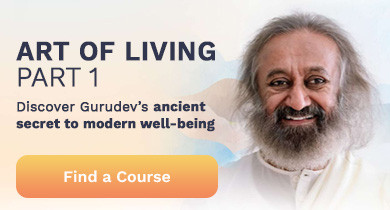By Sejal Shah | Posted: Jun 5, 2018
After Ahimsa, in this series of understanding the Yamas and Niyamas from the Maharishi Patanjali’s Yoga Sutras, let us explore the second of the five yamas — Satya or truthfulness.
What is Satya
The word ‘sat’ literally translates as ‘true essence’ or ‘true nature’. It also means something that is pure and unchangeable. ‘Sat’ also means ‘that which exists’, ‘that which has no distortion’, ‘that which is beyond time, space and person’, and it also means ‘fact’ or ‘reality’.
Being truthful isn’t just as simple as about being truthful in words. Satya is total commitment to truth— in being, in words, in actions, in intentions. The practice of this second yama of Satya requires deep understanding, a lot of awareness, and a delicate balance of honesty.
The highest practice of Satya
Many seekers use this beautiful mantra (sound energy) from the Bṛhadāraṇyaka Upanishads as daily prayer for acknowledging their journey towards the highest truth.
Asato Maa Sad-Gamaya
Tamaso Maa Jyotir-Gamaya
Mrityor-Maa Amritam Gamaya
Om Shanti, Shanti, Shantihi!
“Let my journey be
From the unreal to the real
From darkness (ignorance) to light (knowledge)
From mortality (finite) to immortality (infinite)
Peace, Peace, Peace!”
This universal prayer reflects our commitment towards the highest truth of life.
At the highest level, satya is to be with what is right now, to be connected with something that is not changing—your true nature. We have a tendency to identify or label ourselves with things that are unreal— our thoughts, feelings, moods, actions, experiences, judgements, opinions—all temporary and constantly changing modalities. Moving beyond this tendency and knowing that something deep in you is not changing-—something that is real— is the practice of satya. Satya is having constant awareness of this highest reality or truth.
Truth is not what we speak, but what we are!
To be with what is, to be truthful in one's life, to one's heart, one's presence, one's mind, this is following satya. The clarity and purity in your intention, straight forwardness in your approach, is satya. Your intention, is it truthful? Is your intention straight forward, is your intention clear? Or is there something else behind that? Is there some other hook you are keeping there?' That indicates the truth. Truth is not just what we speak, but what we are, our state of being - integrity in our words, deeds and most importantly in our intentions. It is about being genuine and authentic. When we have such integrity, we become the embodiment of Satya. Our being reflects it, we become Satya.
The nature of truth
Truth is contradictory. Truth is multi-dimensional. It is not black and white. At the surface level, it might appear as conflicting and contradictory, but is really not if you go slightly deeper and understand the context.
There is a Sanskrit couplet that says, “Ekam Sat Vipra Bahudha Vadanti”
The Truth is one, but the intelligent one expresses it in many ways.
As for example, to reach any destination, there could be one direction which says, ‘Go straight and then turn left’. But if you come from another route, it may say, ‘Go straight and then turn right’. Both directions are correct.
Commiting to satya : Practicing satya in daily life
Honest communication and living a life of integrity are the foundation for all of our relationships: with ourselves, with others, and with society as a whole. That is why the practice of Satya is so essential for living a happier and more fulfilled life at both the personal and professional level.
1) Being genuine and authentic
Life is about being true to your own self, reflecting on your actions from that space. Do you feel at home wherever you go? When we are natural with others, we start feeling at home no matter whether we are in the company of complete strangers or with our best buddies. Many times, we cover ourselves up with mannerism, formalities, and societal conditioning in order to be accepted and loved. We should remember that our true selves are our best selves, and that it is alright to be our real ‘self’. This includes talking about things that really matter, or you really believe in, instead of engaging in meaningless chit-chat or gossip just to pass the time or break the silence. When people sense that you are sincere in your words and actions, they will start to trust and respect you. By being your authentic you, you allow and inspire others to live the same way too.
Some people see this as communicating every temporary emotion they have, and continue with bad habits or doings because “this is my real self”. I remember expressing my negative feelings such as fear, anger, jealousy in a group or community meeting in the name of honest confessions. And I realized that I started labeling myself with such feelings, and learned slowly but painfully that such honesty didn’t help me or anybody else. Instead, it lead me to depression, anxiety, and low self-confidence.
But as I progressed on the path of yoga, I learned that our true nature is satchidananda - pure and blissful. All other states of being or feelings are fleeting in nature and arise when we are stressed or when the prana (life force energy) is low. This clarity is so empowering and freeing. Regular practice of yoga helps us to remain in our true nature more and more, and be our genuine self.
2) Speaking truth
In life many times we are faced with situations where it is difficult to be truthful, especially when we are in conflict, or when we perceive some threat to our own security or self image, or when we are greedy and want more than what we deserve.
But, we need to remember that telling the truth may appear difficult at first, however, in the long run, it always works out to our benefit. On the other hand, when you tell a lie, everything may seem very easy in the beginning, but in the long run it brings a lot more trouble and disadvantage than you can imagine. So however we are tempted, instead of taking the shortcut that may appear as easy, let us all vow to take the tougher yet truer route.
The spirit in you longs for the truth and resonates wherever there is truth. Accept it without any feeling or any guilt, and go with it.
3) Nurturing relationships with skillful practice of satya
There is a beautiful Sufi saying:
“Before you speak, let your words pass through three gates.
At the first gate, ask yourself ‘Is it true?
At the second gate ask, ‘Is it necessary?
At the third gate ask, ‘Is it kind?”
Alan Redpath, a well-known British evangelist, pastor and author explains the word “THINK” beautifully.
T—Is it true?
H—Is it helpful?
I—Is it inspiring?
N—Is it necessary?
K—Is it kind?
“If what I am about to say does not pass those tests, I will keep my mouth shut!”
Unfortunately people mistake satya for just speaking words. Many people consider being bluntly honest as truthful. It is very easy to be blunt and be truthful. But does it serve any purpose? Does that help in any way in your relationships either within family or at workplace?
The practice of satya is not about blindly and heedlessly telling the truth without considering the consequences. It is much more about restraint: about taking our time and carefully considering our thoughts and words, so that the way in which we express the truth helps, inspires, uplifts the other human being and nurtures our relationship. Moreover, in telling the truth we should aim to cause the least harm possible. If speaking the truth will cause pain or suffering, then it may be best to remain silent. This is practicing satya in harmony with ahimsa (non-violence).
Some of us are so afraid to hurt someone’s feelings that instead of speaking honestly, we hold our words inside. This is also against satya. If we never tell someone that their behavior is hurtful, or if we hold in all of our pain, we are ultimately suffocating our relationship. Have some quiet time to find ways to express yourself and the truth kindly, mindfully, and with all your sincerity.
At our workplace, there are situations where we need to give feedback to our colleagues or our employees, and at times even to our employer. Feedback has to be honest in order to be useful. But if we develop the skill of giving honest yet encouraging and inspiring feedback, this will definitely create a supportive and nurturing work environment.
By speaking with kind truth, all your relationships will flourish and grow, particularly the most integral relationship – the one with yourself. If you understand and know how to nurture yourself, you will be able to nurture all around you.
Yoga is first and foremost a practice of awareness. Practicing satya in accordance with ahimsa requires awareness of the effect our words and thoughts have on others and ourselves. This requires skill and being in the present moment. Like any other skill, we can develop this skill with dedicated practice.
When we are stressed, who has time to think about the right words to speak? But then we may have to face the undesirable consequences. The practice of yoga asana, pranayama, and meditation can help us manage stress well. This is why all the 8 limbs of yoga are so interconnected. Each limb helps to practice and gain mastery of the other limbs.
4) Finding the purpose of our life
Asking honest questions like what is the purpose of my life, who am I, am I making a difference on this planet, and spending some time to introspect to find honest answers will be very rewarding and transforming. If you are tired of working long days in a job that you do not enjoy, it may be a good time to consider a change to start your truth-finding journey by asking yourself these type of questions. Honest answers can help you shape a more truthful, meaningful and fulfilling life.
5) Satya on the mat
Practicing satya on the mat allows us to always work at our own level and honor where we are each day without any judgments and opinions. We observe our strengths and our weaknesses with the same curiosity and kindness.
The world of social media such as Facebook and Instagram has created a culture of posting images of yoga poses and videos, and sometimes it gives a feeling of ‘show off’ - how good you look in that pose.
We definitely don’t want to shun technology. At the same time we want to use it wisely and want to be mindful that technology doesn’t start ruling us. We need to strike a balance between time for our own practice and time for using technology. When we are practicing, we should be able to completely de-link ourselves from technology even at the subtle thought level. But if you have become so technology-centered that you are not able to give time to your own practice, or you are thinking about selfies and instagram while on your mat for your Om, then you are losing your balance. And it is time to remember that yoga is not about posing in some poses but it is about your inner poise, and it’s time to move away from selfies to discover the self.
When we are on our mat for our daily practice, we need to be honest with ourselves and ask questions like what is the purpose of my practice, am I practicing to uncover my inner light or am I practicing in order to perform some difficult looking yoga postures, or get better than other yogi friends? Asking such questions and allowing honest answers to surface, will help ourselves to move beyond this physical shell, dissolve our ego and limited identity, and help us blossom into our true potentials.
Such a practice of Hatha Yoga, then, becomes a gateway towards experiencing the truth - the union - oneness and connectedness in all our life's experiences.
Benefits of practicing satya - truthfulness
Maharishi Patanjali, the propounder of yoga says,
“Satya pratishtayam kriya phala shrayatvam’’ ( Sutra II 36)
Satya = truth; Pratishtayam = established in; Kriya = action;
Phala = fruits; Shrayatvam = will follow.
“When you are established in truth then the fruits of action will follow.”
Gurudev Sri Sri Ravi Shankar, explains this very beautifully, “When you become established in truth, your actions become fruitful. Any action you do will become fruitful. Many people do their actions, but their actions do not bring about results. There is no truth consciousness inside. When there is truth consciousness inside, when you are established in the truth, the fruit of the action will follow the action immediately. It is the quality of the consciousness, of straight-forwardness. Even if you are telling a lie, you are bold enough to say, “I am telling a lie right now”. Then you are speaking the truth. When you are telling a lie, your consciousness is not solid. It is not straight and forward. It is all wishy-washy. There is no strength behind it. A person who is committed to truth is committed to the presence of the being. For them success comes easily. Not that he will not encounter failure, but he will ultimately win. The slogan ‘We trust in God’ is written on American dollars. On Indian currency, it is written ‘Satyameva jayate’ - ‘Truth alone triumphs’. Truth will eventually win though it may appear not to be winning.”
Mahatma Gandhi started this movement called "Satyagraha" as a method of gaining political and social reforms to make India a free country. This was based first on non-violence and secondly on the truth. Satyagraha translates roughly as "Truth-force." A fuller rendering, though, would be "the force that is generated through adherence to Truth." Gandhi faced a lot of difficulty but ultimately he won the battle for India’s independence.
How do you practice satya in your daily life? How do you handle a conflicting situation when there is a battle between truth vs. lie? How can we inspire and encourage others to practice satya?
Share your observations at blog@us.artofliving.org.
Asatoma sad gamaya...
By Sejal Shah, E-YRT 500 Sri Sri Yoga Teacher, YACEP, Art of Living Teacher, NYU Post Graduate Medical School approved Yoga-CME retreat facilitator, Mind-Body Wellness Writer, Homeopath





























